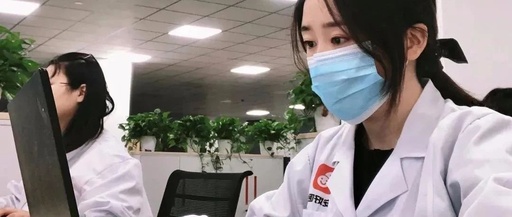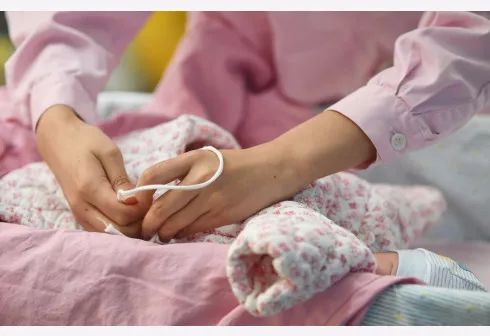 ▲ Nurses are dressing a newborn baby. Source: Xinhua News Agency The full text contains4712 words, reading will take about14 minutes.
▲ Nurses are dressing a newborn baby. Source: Xinhua News Agency The full text contains4712 words, reading will take about14 minutes.
- A small mobile phone screen witnesses the sinking of quality medical resources. In the future, distances will not become a barrier to seeking medical care. Choosing to wear a white coat in a traditional hospital to save lives is the benevolence of a healer; choosing to promote the development of cutting-edge health care through personal efforts and the internet, allowing the benefits of health to reach more people, also honors the sacred oath of “health is at stake, life is entrusted.”
Written by | Xia YuanyuanEdited by | Yi NanAmong every hundred newborns, one unfortunately suffers from some form of congenital heart disease. Once diagnosed, the expensive medical costs and difficult treatments will repeatedly torment the sick children and their families. “Atrial tachycardia.” These six words shattered Zeng Lei’s (pseudonym) psychological defenses. Before she could truly feel the joy of becoming a mother, she noticed that her child was weaker than other children, was restless while breastfeeding, and occasionally had difficulty breathing. Zeng Lei and her family live in a remote village in Gansu. After noticing something was wrong with her child, she and her husband scraped together money and traveled hundreds of kilometers to a town hospital. “A normal child’s heart rate is generally around 100 beats per minute, but his heart rate was basically at 180-190. If this continues, the heart’s contraction function will decline, possibly leading to heart failure.” After reviewing the scans, the doctor suggested surgery, “Let’s do radiofrequency ablation… but the child is too small, and the aftereffects are hard to predict…” Despair felt like a thorny rope, tightening and piercing deeper. Zeng Lei dared not gamble with her child’s life. On the way home on a tractor, the desolation of the autumn harvest on the Loess Plateau was everywhere. The strong winds swept through, leaving only dust and dirt. “There must be other ways.” Zeng Lei remembered seeing information online about finding doctors. She quickly borrowed a neighbor’s computer and posted a request for help on the internet for the first time. Du Zhongdong saw Zeng Lei’s plea. He is a cardiology expert. Hoping to “save more patients,” Du Zhongdong was trying to respond online with a hopeful attitude. He immediately provided a more reasonable treatment plan: “No need for surgery, first control with metoprolol sustained-release tablets and digoxin, and the child will gradually recover by the age of three.” At that time, online consultations were on the rise. In 2013, some cities proposed the concept and implementation plan for smart healthcare; in 2015, the “Guiding Opinions of the State Council on Actively Promoting the ‘Internet +’ Action” was issued, proposing to “promote new models of online medical and health services.” In the same year, the Ping An Good Doctor APP was officially launched. More and more doctors like Du Zhongdong, who care for patients, began to break spatial boundaries to solve health problems for more people; those in need, like Zeng Lei, began to enjoy the rapidly growing benefits of smart healthcare across mountains and seas.1
Screen Changes Destiny
Like Zeng Lei, Li Fang (pseudonym) also fell into despair because of her child. Her child, Ziyue, was diagnosed with “complex congenital heart disease, total anomalous pulmonary venous return” just thirteen days after birth. Looking at the complex medical terms on the diagnosis certificate, Li Fang only understood one thing: “The child is sick, very serious, and will cost a lot of money.” Li Fang and her family live in rural Yan’an, and she and her husband work odd jobs to support the family, living a tight life. They traveled thousands of miles to a big city, and even staying in a small room near the hospital was a huge expense for this family, let alone the high surgical costs. If the surgery fails, they could face losing everything—something these parents could not bear, and they almost gave up. “No, we cannot give up. Modern medicine is so advanced; we must try hard once!” Seeing her child struggling to breathe, the child’s aunt made a decision that would change the child’s fate—she went online to find a doctor. On August 14, 2020, Ping An Good Doctor launched an innovative internet medical model called “Famous Doctor Studio,” aiming to break the barriers of time and space, providing patients with a platform for one-on-one online instant communication with top doctors nationwide. As a chief physician at the Beijing Children’s Hospital affiliated with Capital Medical University, Du Zhongdong joined the Famous Doctor Studio immediately. On the Ping An Good Doctor Famous Doctor Studio platform, the child’s aunt submitted a consultation request to Dr. Du Zhongdong’s team. The resident doctor at the Famous Doctor Studio responded immediately, guiding her to collect and upload the consultation materials. Knowing the situation was urgent, they quickly helped Ziyue schedule an appointment with Dr. Du Zhongdong. “We cannot run around the country every day, but we hope to treat more patients. Through remote consultations, more patients in remote areas can receive better diagnostic services, and many patients will benefit from this.” Du Zhongdong said, “In addition, Ping An Good Doctor’s AI technology can also help more grassroots doctors improve consultation efficiency. For example, by setting six diagnostic symptoms for Kawasaki disease, as long as the patient meets five of them, a preliminary judgment can be formed.” During holidays, Du Zhongdong receives local specialties from all over the country, signed and unsigned, behind which are heavy thanks. He also keeps a message sent by Zeng Lei from years ago: “When the child grows up, I will definitely let him study medicine!” If we want patients in remote areas to avoid the suffering of long journeys and reduce the crowds in large hospitals, platforms like Ping An Good Doctor and the strong medical resources behind them play a very important role.2
The Life-Saving Rescue from Afar
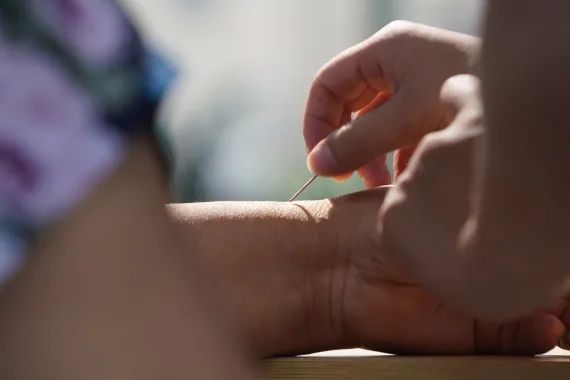 ▲ Patients undergoing examination. Source: Xinhua News AgencyLife in middle age feels like a taut hemp rope, pulled at both ends—one end hopes for a soaring paycheck, while the other fears abnormal health check reports. Xuyun (pseudonym) deeply feels this. In November 2019, during the busiest time of the year, his body sounded the alarm: what originally was just occasional chest tightness and shortness of breath turned into swollen legs, and sometimes he could not lie flat. “I’m too busy at work,” he had no time to go to the hospital for a more detailed examination, so he simply explained his situation to cardiologist Yu Hui on the Ping An Good Doctor platform and sent over previous echocardiograms and abdominal ultrasounds. On the echocardiogram, Xu Yun’s heart already had a large amount of pericardial effusion, with a depth of 7cm. Combined with the abdominal ultrasound showing liver congestion, he was at risk of pericardial tamponade at any moment. Pericardial tamponade is a common cardiac emergency that can easily lead to acute circulatory failure or even sudden death. Yu Hui felt a tightness in her chest and immediately messaged Xu Yun: “Hurry to the hospital!” “Ah, is it that urgent?” Xu Yun was skeptical. This discomfort had persisted for a while without any major issues, so he casually replied, “I know, I will go to the hospital tomorrow.” After saying that, he continued to focus on work. “You can’t wait until tomorrow; you need to go quickly!” Yu Hui noticed the avatar on the platform going dark, realizing that the patient did not take her words seriously. This was a dangerous signal. Almost instinctively, she immediately contacted the customer service department of Ping An Good Doctor to obtain Xu Yun’s contact number. On the phone, Xu Yun still did not realize the severity of the problem: “It’s not that serious; I just occasionally feel a bit of chest tightness, and the palpitations go away after a while. It’s not dangerous, right?” “Heart problems are like this; even if you don’t feel anything now, the echocardiogram shows a large amount of fluid in your pericardium, with a risk of tamponade that could happen at any moment, leading to persistent hypotension and malignant arrhythmias.” While on the call, Yu Hui had already checked all the local tertiary hospitals based on Xu Yun’s address and even provided the best route to the nearest tertiary hospital, “You must go to the nearest tertiary hospital for emergency drainage immediately. Otherwise, you could be in life-threatening danger. Don’t drive yourself, and avoid strenuous activities… I suggest you call 120; they can handle any issues…” Xu Yun finally followed Dr. Yu Hui’s advice and called 120 for medical assistance. Yu Hui kept track of Xu Yun’s medical situation until he safely arrived at the emergency department of the hospital, finally letting out a sigh of relief. In her view, one of the advantages of internet healthcare is the ability to continuously track patient conditions and maintain communication over time. “When seeing patients offline, if I’m not on duty or take a break, I might miss communication with patients or fail to ensure continuity of treatment. But now, even if I’m not online, the system is set up to keep interacting with patients through intelligent questions, and I can review and study all the materials and responses repeatedly.” 2020 was the second year for Yu Hui to transition into an internet doctor. Last July, she gave up her permanent position at a public hospital and plunged into the blue ocean of internet healthcare.
▲ Patients undergoing examination. Source: Xinhua News AgencyLife in middle age feels like a taut hemp rope, pulled at both ends—one end hopes for a soaring paycheck, while the other fears abnormal health check reports. Xuyun (pseudonym) deeply feels this. In November 2019, during the busiest time of the year, his body sounded the alarm: what originally was just occasional chest tightness and shortness of breath turned into swollen legs, and sometimes he could not lie flat. “I’m too busy at work,” he had no time to go to the hospital for a more detailed examination, so he simply explained his situation to cardiologist Yu Hui on the Ping An Good Doctor platform and sent over previous echocardiograms and abdominal ultrasounds. On the echocardiogram, Xu Yun’s heart already had a large amount of pericardial effusion, with a depth of 7cm. Combined with the abdominal ultrasound showing liver congestion, he was at risk of pericardial tamponade at any moment. Pericardial tamponade is a common cardiac emergency that can easily lead to acute circulatory failure or even sudden death. Yu Hui felt a tightness in her chest and immediately messaged Xu Yun: “Hurry to the hospital!” “Ah, is it that urgent?” Xu Yun was skeptical. This discomfort had persisted for a while without any major issues, so he casually replied, “I know, I will go to the hospital tomorrow.” After saying that, he continued to focus on work. “You can’t wait until tomorrow; you need to go quickly!” Yu Hui noticed the avatar on the platform going dark, realizing that the patient did not take her words seriously. This was a dangerous signal. Almost instinctively, she immediately contacted the customer service department of Ping An Good Doctor to obtain Xu Yun’s contact number. On the phone, Xu Yun still did not realize the severity of the problem: “It’s not that serious; I just occasionally feel a bit of chest tightness, and the palpitations go away after a while. It’s not dangerous, right?” “Heart problems are like this; even if you don’t feel anything now, the echocardiogram shows a large amount of fluid in your pericardium, with a risk of tamponade that could happen at any moment, leading to persistent hypotension and malignant arrhythmias.” While on the call, Yu Hui had already checked all the local tertiary hospitals based on Xu Yun’s address and even provided the best route to the nearest tertiary hospital, “You must go to the nearest tertiary hospital for emergency drainage immediately. Otherwise, you could be in life-threatening danger. Don’t drive yourself, and avoid strenuous activities… I suggest you call 120; they can handle any issues…” Xu Yun finally followed Dr. Yu Hui’s advice and called 120 for medical assistance. Yu Hui kept track of Xu Yun’s medical situation until he safely arrived at the emergency department of the hospital, finally letting out a sigh of relief. In her view, one of the advantages of internet healthcare is the ability to continuously track patient conditions and maintain communication over time. “When seeing patients offline, if I’m not on duty or take a break, I might miss communication with patients or fail to ensure continuity of treatment. But now, even if I’m not online, the system is set up to keep interacting with patients through intelligent questions, and I can review and study all the materials and responses repeatedly.” 2020 was the second year for Yu Hui to transition into an internet doctor. Last July, she gave up her permanent position at a public hospital and plunged into the blue ocean of internet healthcare.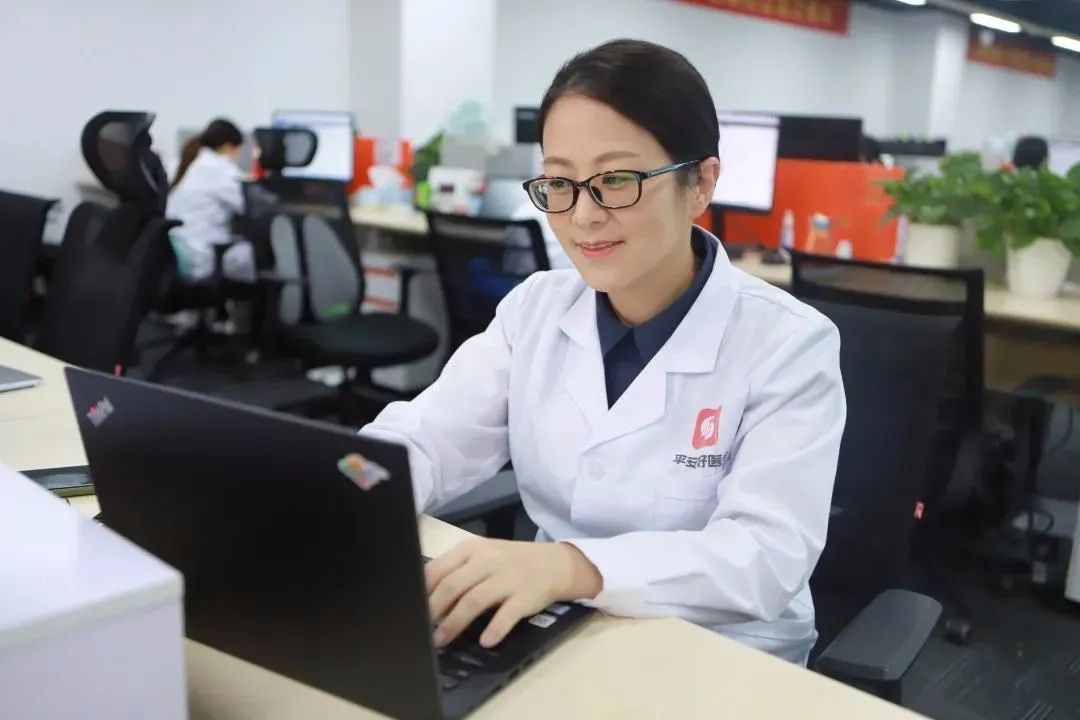 ▲ Yu Hui, cardiologist at Ping An Good Doctor Yu Hui worked for 15 years at the Changhai Hospital affiliated with the Naval Medical University. She understands better than most the medical issues that cannot be solved by individual efforts—inequitable resource distribution and information asymmetry leading to low medical efficiency… “Every morning, I see a crowded outpatient hall, and it doesn’t get less crowded until after work. At most, I need to consult over three hundred patients in a day, with patients waiting for three hours, and the consultation ends in three minutes. Many details are not that I don’t want to delve into, but I simply don’t have the time. I always felt that the current medical situation could be better.” Yu Hui vaguely realized that the rising internet healthcare might have the power to change the status quo. Currently, the daily consultation volume of online diagnosis and treatment on the Ping An Good Doctor platform exceeds 830,000, equivalent to the total daily outpatient volume of nearly a hundred tertiary hospitals in China. Online consultations ensure that each patient has at least 15 minutes of communication time with the doctor, and the program is designed to provide users with humanistic care content, such as lifestyle advice and follow-up management, improving medical efficiency while alleviating the sense of unfamiliarity between doctors and patients during offline visits. Beyond the program, there are vibrant individuals. Compared to hastily diagnosing and prescribing for patients, Yu Hui enjoys establishing a “warm” connection with patients now. Through each inquiry and answer, she feels as if she is stepping in front of each specific patient, providing them with gentle, soothing strength. A university student with arrhythmia often consults Yu Hui. She rarely mentions her condition, always sharing her daily life like telling a story. Yu Hui hopes to protect this sensitive and fragile connection, and besides encouragement, she often shares happy moments from her life, allowing a ray of sunshine to slowly enter the patient’s heart. “Gradually, she rarely calls me ‘Dr. Yu’ but directly calls me ‘sister’ and asks me to help analyze her reports after seeing a doctor offline, following some of my suggestions,” Yu Hui said, “Compared to offline, online consultations require us to have higher professional qualities and more comprehensive professional abilities.” The emotional knots that patients cannot untie in reality gradually unfold under Yu Hui’s guidance.3
▲ Yu Hui, cardiologist at Ping An Good Doctor Yu Hui worked for 15 years at the Changhai Hospital affiliated with the Naval Medical University. She understands better than most the medical issues that cannot be solved by individual efforts—inequitable resource distribution and information asymmetry leading to low medical efficiency… “Every morning, I see a crowded outpatient hall, and it doesn’t get less crowded until after work. At most, I need to consult over three hundred patients in a day, with patients waiting for three hours, and the consultation ends in three minutes. Many details are not that I don’t want to delve into, but I simply don’t have the time. I always felt that the current medical situation could be better.” Yu Hui vaguely realized that the rising internet healthcare might have the power to change the status quo. Currently, the daily consultation volume of online diagnosis and treatment on the Ping An Good Doctor platform exceeds 830,000, equivalent to the total daily outpatient volume of nearly a hundred tertiary hospitals in China. Online consultations ensure that each patient has at least 15 minutes of communication time with the doctor, and the program is designed to provide users with humanistic care content, such as lifestyle advice and follow-up management, improving medical efficiency while alleviating the sense of unfamiliarity between doctors and patients during offline visits. Beyond the program, there are vibrant individuals. Compared to hastily diagnosing and prescribing for patients, Yu Hui enjoys establishing a “warm” connection with patients now. Through each inquiry and answer, she feels as if she is stepping in front of each specific patient, providing them with gentle, soothing strength. A university student with arrhythmia often consults Yu Hui. She rarely mentions her condition, always sharing her daily life like telling a story. Yu Hui hopes to protect this sensitive and fragile connection, and besides encouragement, she often shares happy moments from her life, allowing a ray of sunshine to slowly enter the patient’s heart. “Gradually, she rarely calls me ‘Dr. Yu’ but directly calls me ‘sister’ and asks me to help analyze her reports after seeing a doctor offline, following some of my suggestions,” Yu Hui said, “Compared to offline, online consultations require us to have higher professional qualities and more comprehensive professional abilities.” The emotional knots that patients cannot untie in reality gradually unfold under Yu Hui’s guidance.3
Unfailing Companionship
This may be the best of times; the vigorous development of internet technology has made “suspending threads to feel pulses” no longer a medical myth; consultations across screens also place higher professional demands on doctors. “As the end of the year approaches, the latest clinical guidelines in various medical subfields are being released one after another. I will use my spare time to read and study the latest guidelines to update my knowledge base in a timely manner,” said He Zhihui, a general practitioner at Ping An Good Doctor. “Online consultations allow more time to care for patients’ emotions, so I also read some psychology-related books.” Unlike Yu Hui’s “every second counts,” He Zhihui deals more with chronic disease patients. Chronic diseases refer to long-term, non-self-healing, and almost incurable diseases that gradually erode patients’ health. Over 50% of chronic disease patients experience varying degrees of psychological issues, such as fear and anxiety. These patients require more patience and attention. Chen Gang (pseudonym) left a deep impression on He Zhihui during his consultation process, as he inquired about frequent urination for his elderly mother—this is a common symptom of many age-related diseases that severely disrupt patients’ lives. He Zhihui specializes in the integrated treatment of common internal diseases using both Chinese and Western medicine, particularly adept at using TCM theories to comprehensively adjust patients’ constitutions. After carefully studying the patient’s physical condition, medication history, and dietary habits, she determined that the elderly woman suffered from kidney yang deficiency leading to bladder dysfunction and decided to use a Chinese herbal formula for her adjustment. To provide more accurate medication advice, He Zhihui asked many questions about daily habits. Chen Gang had been taking care of his mother himself, ensuring regular meals, “But perhaps due to her blindness, my mother has recently been a bit confused: sometimes she cannot distinguish between day and night, turning on the TV at two or three in the morning, and sometimes wandering aimlessly around the room…” Every detail pieced together the key. He Zhihui quickly realized that this blind patient also had time and space cognitive impairment, a typical symptom of Alzheimer’s disease, and she hurriedly reminded Chen Gang to take his mother to the hospital for a more detailed examination. Faced with this signal, Chen Gang was evidently a bit negative, “I’ve heard people say that Alzheimer’s disease is senile dementia, and this disease cannot be cured, so why check it? Just take good care of her…” Chen Gang’s view represents the misunderstanding many have about Alzheimer’s disease. He Zhihui detailed the home care precautions for Alzheimer’s patients and answered all of Chen Gang’s questions. 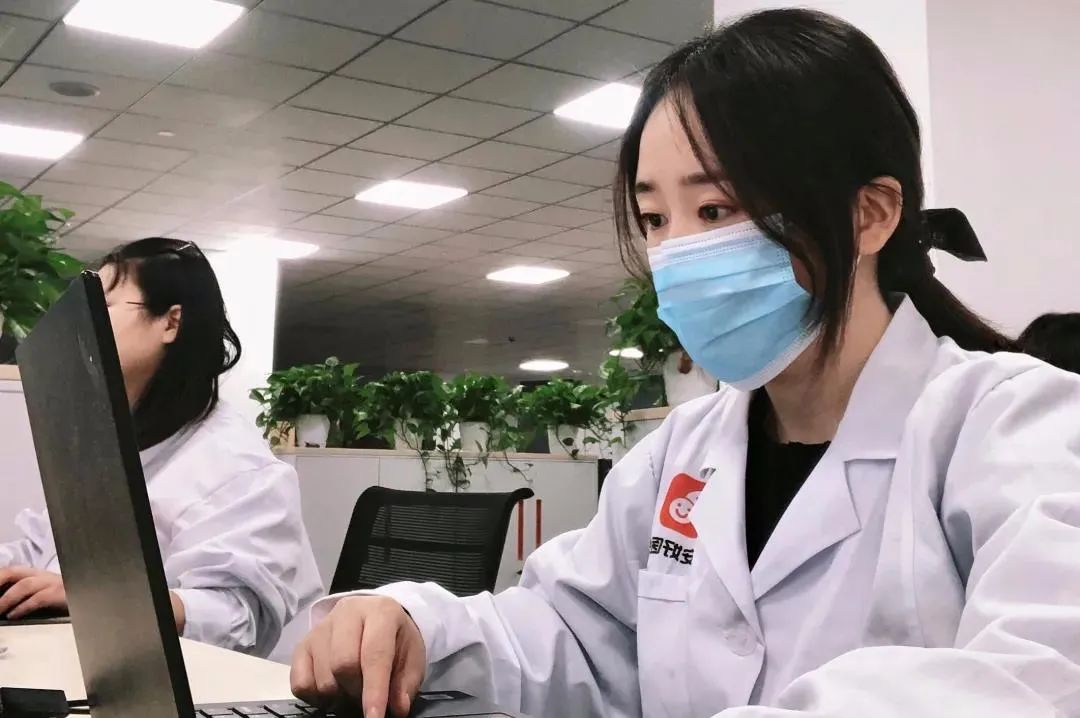 ▲ He Zhihui, general practitioner at Ping An Good Doctor Many users like Chen Gang, who inquire for their parents, are not few. In He Zhihui’s view, in offline hospital outpatient settings, the dry-mouthed doctors and anxious patients, along with delayed communication, lower consultation efficiency. These factors, which easily generate doctor-patient conflicts, are somewhat avoided and alleviated in the intelligent medical system of online platforms. Across a screen, with every keystroke, every sound of electricity flowing, and every clear image, professionalism and goodwill are conveyed to users’ hearts, gradually rebuilding and nurturing trust. In 2019, there were as many as 300 million chronic disease patients in China. According to the “Healthy China Action (2019-2030),” chronic diseases have become the main cause of death and disease burden for residents, accounting for over 70% of the total disease burden, becoming a significant factor restricting health. If we compare chronic disease management to a reservoir, chronic obstructive pulmonary disease, diabetes, Alzheimer’s disease, cardiovascular diseases, and other different diseases are the droplets within it. In modern medical institutions, doctors are distributed across various specialties, mostly facing chronic disease patients with complications. More patients like Chen Gang’s mother, who are immobile and require long-term health management, urgently need more standardized guidance and companionship. Ezra Emanuel, a former health advisor to the U.S. government, also mentioned an effective case of chronic disease management in “The Future of Prescriptions”: “There is no high technology, and it’s not complicated; it relies on a lot of interpersonal interactions to ensure that every high-cost, high-risk patient always receives basic medical care.” Experience benefits from practice. Utilizing internet hospital methods to move medical access forward, transforming the medical model from “disease-centered” to “health-centered” is what Ping An Good Doctor is doing. On one hand, it allows medical resources to benefit more people; on the other hand, it enables more people to enjoy a healthy life more efficiently, conveniently, and at a lower cost. A small mobile phone screen witnesses the sinking of quality medical resources. In the future, distances will not become a barrier to seeking medical care. Choosing to wear a white coat in a traditional hospital to save lives is the benevolence of a healer; choosing to promote the development of cutting-edge health care through personal efforts and the internet, allowing the benefits of health to reach more people, also honors the sacred oath of “health is at stake, life is entrusted.” (Special Topic)
▲ He Zhihui, general practitioner at Ping An Good Doctor Many users like Chen Gang, who inquire for their parents, are not few. In He Zhihui’s view, in offline hospital outpatient settings, the dry-mouthed doctors and anxious patients, along with delayed communication, lower consultation efficiency. These factors, which easily generate doctor-patient conflicts, are somewhat avoided and alleviated in the intelligent medical system of online platforms. Across a screen, with every keystroke, every sound of electricity flowing, and every clear image, professionalism and goodwill are conveyed to users’ hearts, gradually rebuilding and nurturing trust. In 2019, there were as many as 300 million chronic disease patients in China. According to the “Healthy China Action (2019-2030),” chronic diseases have become the main cause of death and disease burden for residents, accounting for over 70% of the total disease burden, becoming a significant factor restricting health. If we compare chronic disease management to a reservoir, chronic obstructive pulmonary disease, diabetes, Alzheimer’s disease, cardiovascular diseases, and other different diseases are the droplets within it. In modern medical institutions, doctors are distributed across various specialties, mostly facing chronic disease patients with complications. More patients like Chen Gang’s mother, who are immobile and require long-term health management, urgently need more standardized guidance and companionship. Ezra Emanuel, a former health advisor to the U.S. government, also mentioned an effective case of chronic disease management in “The Future of Prescriptions”: “There is no high technology, and it’s not complicated; it relies on a lot of interpersonal interactions to ensure that every high-cost, high-risk patient always receives basic medical care.” Experience benefits from practice. Utilizing internet hospital methods to move medical access forward, transforming the medical model from “disease-centered” to “health-centered” is what Ping An Good Doctor is doing. On one hand, it allows medical resources to benefit more people; on the other hand, it enables more people to enjoy a healthy life more efficiently, conveniently, and at a lower cost. A small mobile phone screen witnesses the sinking of quality medical resources. In the future, distances will not become a barrier to seeking medical care. Choosing to wear a white coat in a traditional hospital to save lives is the benevolence of a healer; choosing to promote the development of cutting-edge health care through personal efforts and the internet, allowing the benefits of health to reach more people, also honors the sacred oath of “health is at stake, life is entrusted.” (Special Topic)

